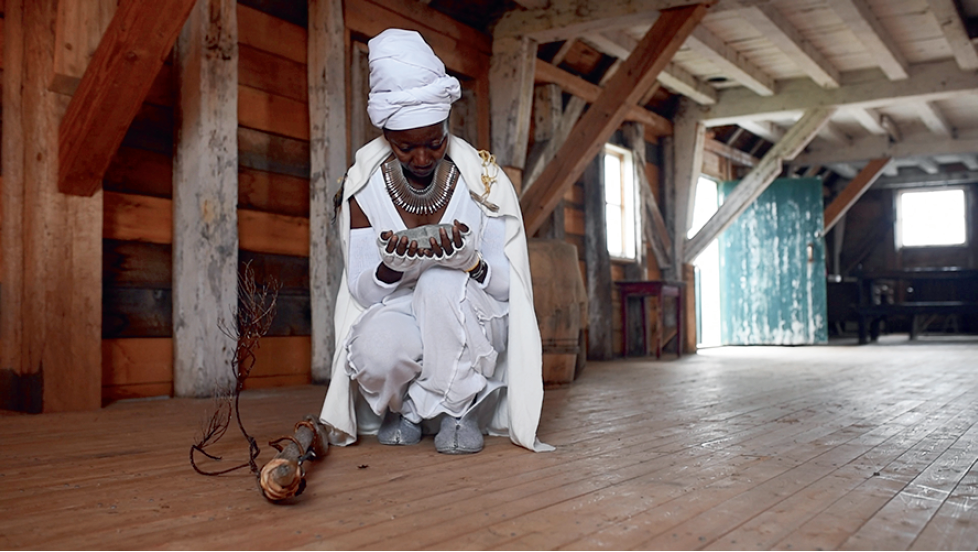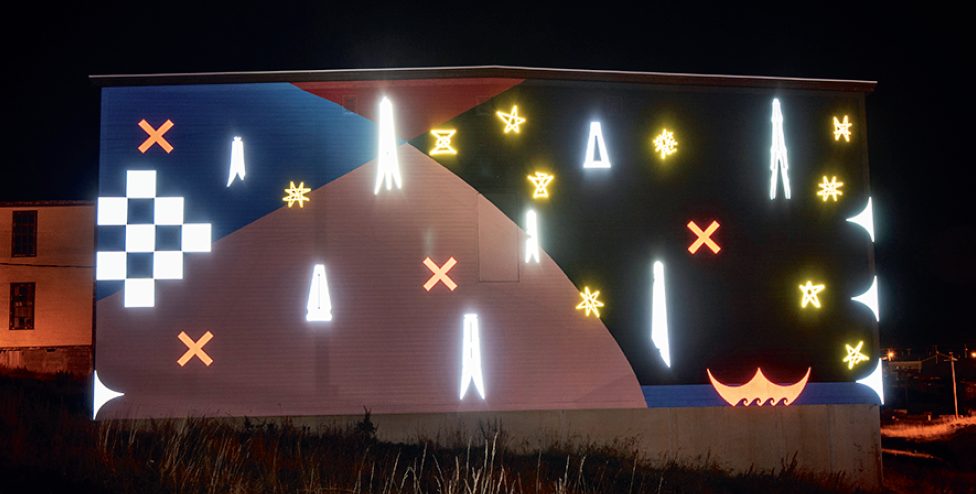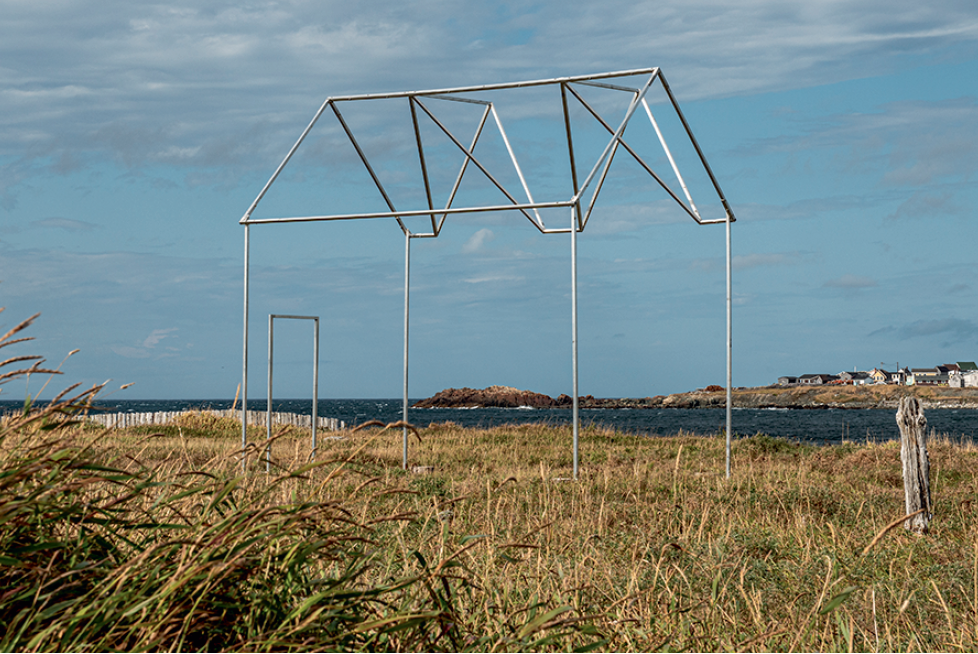Bonavista Biennale
The 2019 Bonavista Biennale featured 22 exhibitions spread across Newfoundland’s remote Bonavista Peninsula. Viewers had to drive along twisting back roads and wander on foot through small communities (many of which don’t have cell reception) to find venues and outdoor installations marked by numbered signs.
I visited the festival in its opening week and spent two days roaming the peninsula, taking in sitespecific work by local and visiting artists. Many of the pieces in this year’s Biennale examine collective memory and the ways the past inhabits and informs the present in Newfoundland. Many of the exhibitions were housed in buildings that once played an important part in the area’s fishing industry. The use of these empty spaces emphasized how factors like the province’s aging population, out-migration and a lack of government investment in rural Newfoundland have changed life on the Bonavista Peninsula. Communities that had sustained themselves through a lively fishery now rely heavily on tourism.

Camille Turner, The Afronautic Research Lab, 2016–present. Still from video, 6 min., 20 sec. Fish store, Mockbeggar Plantation, Bonavista, NL. All photos: Brian Ricks. Images courtesy the Bonavista Biennale, Bonavista, NL.
In the town of Bonavista itself, Jordan Bennett’s vibrant mural, Pi’tawe’k, and Camille Turner’s immersive multimedia installation, The Afronautic Research Lab, both deal with Newfoundland histories that have faced erasure. Pi’tawe’k is beside Bonavista’s Wellness Centre, a space that combines a community kitchen, fitness centre, child-care centre and public gymnasium with a view of an active marina. Bennett has painted the building’s clapboard in swaths of salmon pink, bright blue, burgundy and black. Large symbols cut from a reflective metal used to make road signs are attached to the mural. Up close, you can see that the metallic shapes are covered in fine lines, creating a pattern like fish scales. Bennett’s artist statement explains that the imagery in Pi’tawe’k is his interpretation of Mi’kmaq and Beothuk visual culture. In the evening the reflective symbols on the building glow, evoking the presence of the dynamic and evolving cultures that colonialist narratives often depict as either non-existent or as stagnant relics. When Newfoundland joined Canada in 1949, Premier Joey Smallwood claimed there were “no Indians” on the island—a reference to the fact that until 1973 no Indigenous peoples in Newfoundland were recognized under the Canadian Indian Act. The bright colours and radiant symbols make Bennett’s piece feel like a celebration of the resilience of Mi’kmaq and Beothuk culture in the face of colonialist forces of erasure.
Leaving the mural, I followed a map printed on the back of the Biennale pamphlet to Turner’s The Afronautic Research Lab, passing a clothesline hung with a row of drying squid swaying in the sun and then a small cafe where you could order cappuccinos and vegan breakfast options. The Afronautic Research Lab was installed in a building alongside the cafe, the former fish store. When the fishery was thriving, cod would have been kept in this space until it was shipped out of Newfoundland; now the empty building is preserved as an historic site.

Jordan Bennett, Pi’tawe’k, 2019. Installation view (night). Wellness Centre exterior wall, Bonavista, NL.
The Afronautic Research Lab transformed the fish store into a futuristic reading room where viewers are encouraged to engage with the legacy of Canada’s and more specifically Newfoundland’s role in the transatlantic slave trade. The installation is part of an ongoing piece that Turner has been adapting since 2016. The Afronautic Research Lab was built around the concept that Afronauts, descendants of the Dogon people of Mali, have returned from the future to save the planet and are inviting citizen researchers to help them confront “Canada’s historical amnesia” concerning its role in the transatlantic slave trade.
In the fish store, research materials are spread out on a long table lit by white lamps with red and blue bulbs. There are mechanical pencils and magnifying devices scattered across the table along with stacks of real academic papers, historical documents and published books. Yellow sticky notes mark significant passages; some sentences are underlined. In one corner, 19 flash cards are arranged in a semicircle on the floor. Written in black marker on each card is the name of a ship constructed in Newfoundland in the late 18th century that was used to transport slaves. Growing up as a white settler in Newfoundland, I never learned about Newfoundland’s involvement in the transatlantic slave trade. It was sickeningly arresting to see Torbay, the name of a community close to my own home in St. John’s, written on one of the cards.
On a screen at the back of the room, Camille Turner stands at the edge of a cliff in flowing white robes and a cape, holding a weathered stick. The dramatic landscape and some small touches on her wardrobe signal that she is in Newfoundland; a section of braided yellow nylon rope, the kind often used on small fishing vessels, is incorporated into the cape, and a devil’s purse, the colloquial name for the pouches that protect shark skate eggs and litter beaches on the island, is attached to her shoulder. A poetic voice-over plays from a speaker in the corner of the room. The narrator announces, “I tell stories of silence.” The intricate installation is powerful because it forces viewers to confront not only the horrific reality of the transatlantic slave trade but also our desire as a province to obscure our own complicity in it.
After leaving The Afronautic Research Lab, I walked along the shoreline looking for Robert Hengeveld’s passing where to. The sign for Hengeveld’s piece pointed at an empty stretch of beach. Eventually I found a volunteer, who explained it was a moving exhibition that was located in Upper Amherst Cove that day, about a 20-minute drive from Bonavista.

Robert Hengeveld, passing where to, 2019. Installation view, Bonavista, NL.
From a distance, Hengeveld’s installation looked like a gleaming line drawing sketched on the horizon. The metal structure glinted in the sun, creating the elegant outline of a house with a gabled roof and two dormer windows in the front made from aluminum tubing.
Hengeveld’s sculptural installation evoked the resettlement of communities in Newfoundland in the 1950s. When Premier Joey Smallwood launched a program that saw entire communities leave their homes in order to centralize services on the island, people famously dragged their houses to the ocean and floated them across the bay, leaving behind a way of life along with ghost towns of foundations and abandoned buildings. As our province faces bankruptcy once again, the question of how to distribute resources across a geographically large province populated with clusters of very small communities is becoming increasingly pressing. Hengeveld’s delicate moving house is symbolic of both the homes that were floated away in the early 1950s and the precarity that people living in rural Newfoundland face today. Like Bennett’s and Turner’s, Hengeveld’s work urges the viewer to consider how Newfoundland’s past continues to reverberate through its present. ❚
The Bonavista Biennale, Bonavista Peninsula, NL, ran from August 17 to September 15, 2019.
Eva Crocker is a freelance writer based in St. John’s, Newfoundland. She is the author of the award-winning short story collection Barrelling Forward; her debut novel, All I Ask, will be published by House of Anansi Press in spring 2020.
To read the rest of Issue 152, order a single copy here.

